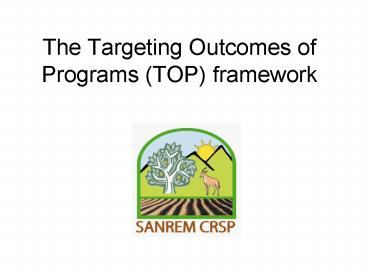The Targeting Outcomes of Programs (TOP) framework - PowerPoint PPT Presentation
1 / 26
Title:
The Targeting Outcomes of Programs (TOP) framework
Description:
The Targeting Outcomes of Programs (TOP) framework Why use the TOP framework? Facilitates the systemization of project development. Provides mechanism to build in ... – PowerPoint PPT presentation
Number of Views:177
Avg rating:3.0/5.0
Title: The Targeting Outcomes of Programs (TOP) framework
1
The Targeting Outcomes of Programs (TOP)
framework
2
Why use the TOP framework?
- Facilitates the systemization of project
development. - Provides mechanism to build in indicators from
outset. - Facilitates proposal assessment in terms of the
feasibility of project results/impacts.
3
What is the TOP Framework?
- The Targeting Outcomes of Programs (TOP)
framework is an evaluative framework that can be
used both to develop proposals and to evaluate
project results.
4
The framework has 7 levels that can be developed
downwards for the proposal and then evaluated
upwards for the results
5
The global generic problem area should be defined
before starting work on the TOP framework
6
The DOWNWARDS segment(Project Development)
- Needs assessment steps
- SEE Conditions
- Practices
- KASA
- Opportunity assessment steps
- Stakeholders
- Research
- Tasks
- Resources
7
Needs assessment
- This is the planning stage
- This stage also provides the indicators for later
project evaluation
8
SEE Conditions
- Needs Assessment for long-term IMPACT
- S Social (class/gender/ethnic/religious
minorities). - E Economic (livelihoods, markets, trade).
- E Environmental (soil and water quality,
biodiversity). - Take all three dimensions into account.
9
PRACTICES
- Analyze current practices at landscape system
levels. - Example
- Current practices around soil management of
grazing land? - Whose practices (mens/womens/the poor/which
ethnic group)? - Under what conditions are practices performed?
(When? Using what resources and which techniques?)
10
KASA Knowledge, Attitudes, Skills, Aspirations
- Identify stakeholder populations
- Collect data to be used to establish a
quantitative baseline on practices identified in
previous step at the appropriate landscape
systems levels. - If possible use secondary data, otherwise carry
out a survey
11
Opportunity Assessment
- Take the above research plan
and work out how to adapt it
to specific conditions on the ground - (Proposal for full project)
12
Step 1 stakeholder negotiation
- Identify stakeholders to establish research sites
- Negotiate with them to adapt problem statement to
their circumstances. - Example
- The three major problem areas we will address
are - Soil erosion in the watershed
- Over-usage of chemicals in farming practices
- Womens lack of access to technical assistance
13
Step 2 Design research strategies
- Engage stakeholders to design research strategies
to address identified problems - Example
- Identify alternative strategies to reduce soil
erosion together with farmers by changing
burn-off practices, building bunds, planting
trees/bushes - Identify alternative pest control methods to
reduce chemical usage - Work with extension agencies to identify ways of
improving services for women.
14
Step 3 Task specification
- Together with stakeholders identify tasks and
task assignments necessary to implement each
strategy. - Example
- Work with farmers to test alternatives
- Train extension agents
- Build bunds
15
Step 4 Identity resources for the budget
- Collaboratively consider the resources you will
need for this. - Example
- Training Personnel
- Administrative personnel
- Costs of training sessions
- Costs of inputs on farms
- Costs of farmer collaboration
- Supplies and Equipment
16
The UPWARDS segment Project Evaluation
- Outputs
- Resources
- Tasks completed
- Research results
- Stakeholder reactions
- Impacts
- KASA
- Practices
- SEE Outcomes
17
Outputs/Impacts
- Project outputs are directly under the control of
the project - Resources utilized,
- farmers/extension workers trained
- Impacts are the effect the project has produced
on people, the economic situation and the
environment - These can be immediate, medium or long term
18
Resources(Outputs)
- Were the resources available and utilized as
planned? - How relevant/necessary was each resource to your
activities? - How adequate?
- How well utilized?
19
Tasks Completed (Outputs)
- Completed on schedule and as conceived?
- What went well?
- What problems did you have?
20
Research Results (outputs)
- What reports, publications, additions to the
knowledge database has your project produced? - Did targeted stakeholders participate?
- Was a special effort made to integrate
disadvantaged groups?
21
Stakeholder Reactions (outputs)
- Were the stakeholders satisfied?
- Were there significant differences among the
different groups? - What about the reactions of the disadvantaged
groups? - Were everyones concerns addressed?
22
KASA Knowledge, Attitudes, Skills, Aspirations
(Impact)
- Conduct ex-post survey to compare with baseline
data to assess short-term impact on these 4
elements.
23
Practices (Impact)
- If you found significant impacts at the KASA
level, practices should have changed
correspondingly. - In this step you assess these changes.
- Are they what you were looking for?
- Are the changes across the board?
- Have some groups changed more?
- Why did this happen?
24
SEE Outcomes (top level impact)
- Collect overall impact indicators at macro level
in all three dimensions. - Include all marginalized groups (women, children,
religious and ethnic minorities, lower classes,
poor, uneducated) in social and economic
assessments. - Quantify environmental benefits (direct and
indirect measures).
25
Overall impact of the TOP framework on SANREM
- Use of TOP framework by all projects will ensure
consistent proposal evaluation. - Its use will facilitate MEs evaluation of
overall project results. - It will help integrate indicators across
projects. - This will allow for clear and compact reporting.
26
Across-the-Board Reconciliation
- When all the projects to be funded are identified
the ME and TC will sit down with all teams to
identify similarities at multiple levels, and
also to locate cross-cutting themes and
indicators.






























